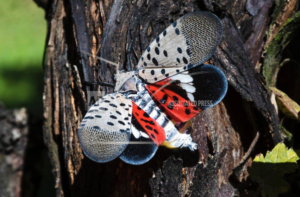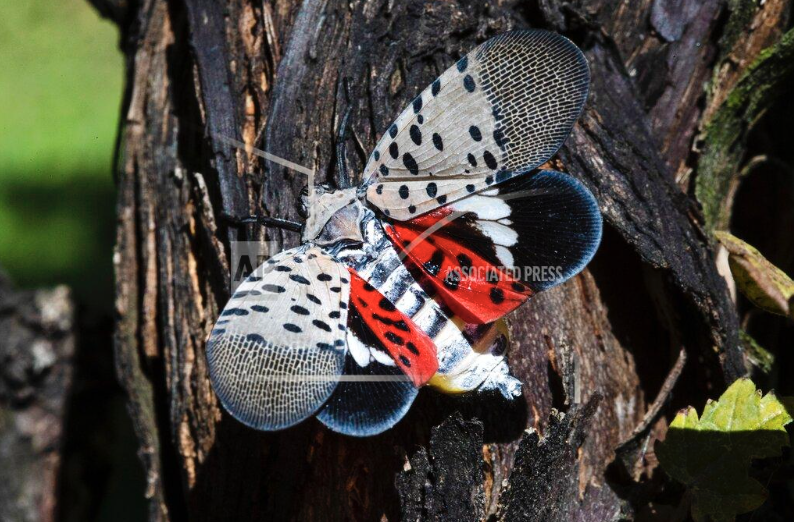The spotted lanternfly is invading New York, and so far, an array of countermeasures — from vacuums and insecticides to official recommendations to stomp the bugs on sight — don’t seem to be helping much.

On a recent Sunday afternoon on a rooftop restaurant in Lower Manhattan, a swarm of the black-and-red winged plant-hoppers, originally from Asia, personally joined this reporter for lunch, helping themselves to my crispy pulled pork sandwich. They crept not only all across the ground but also on my chair, table, and plate. Two of the inch-long bugs even landed on my shoulder. It goes without saying that my dining experience was tarnished.
Scientists and government officials are currently trying to find new strategies to resist the pesky lanternflies, which have no natural predators. It’s an urgent task: while the bug is mostly just a nuisance for city dwellers, it is a major potential threat to New York’s $6.65 billion grape and wine industry. When spotted lanternflies feed on plants, including grapevines, they release a sticky honeydew that grows mold and prevents photosynthesis, killing the plant.
For now, state officials aren’t sure how serious the problem is in New York, as survey efforts are just beginning. But they’ve already identified infestations in a couple of locations near vineyards in the Hudson Valley, and there’s little doubt that there will be more soon.
“The spotted lanternfly is a very good hitchhiker,” said Chris Logue, who heads the plant industry division of the New York State Department of Agriculture and Markets. “A number of spotted lanternflies have been found on aircrafts going from the East to West Coast.” There are concerns about these unwanted passengers traveling across city, state, and even national borders, especially in transportation hubs like New York City. Control efforts are focusing on highways, railroads, airports, and seaports, as well as the state’s vineyards. The department is urging grape growers to use additional insecticides, and to be on the lookout for early signs of infestation. Vacuums are also being used to suck up large clusters of lanternflies, mostly before egg laying season begins in the fall — for each female fly that is killed, 60 to 100 adults are eliminated the following year.
The bug first appeared in the U.S. in Pennsylvania in 2014 and has since spread quickly, arriving in New York in 2020 on Staten Island. State agricultural officials have urged New Yorkers to stamp out the bug when they see one, but killing them one by one is unlikely to make a significant dent in the population.
However, the public can make a difference by looking out for egg masses. “Obviously, this is a key time when we could eliminate or reduce the population using egg mass removal, so it’s key that the public knows what an egg mass looks like,” said Matthew Travis, national policy manager at the U.S. Department of Agriculture’s Animal and Plant Health Inspection Service. The average mass is about 1.5 inches long and brown or gray. Websites like hungrypests.com and stopslf.org show the spotted lanternfly throughout its life cycle, and can help people to identify and dispose of egg masses. “If you’re moving outdoor furniture or camping equipment, stuff like that, now is the time that people need to be vigilant and aware of what their surroundings are,” Travis said.
Scientists don’t yet fully understand the insect’s basic biology, which makes the population more difficult to control — though there has been some progress. A recent study found that spotted lanternflies are attracted to their own honeydew secretions. Males are attracted to male honeydew, while females are not, and both males and females have a slight attraction to female honeydew. However, when looking at specific compounds within the secretion, some were attractive to males, others to females, and one attracted both, while yet another compound repelled females.
It’s a confusing picture, acknowledges Miriam Cooperband, an entomologist at the Department of Agriculture and an author of the new study. “The results were a little unexpected,” she said. “We had evidence from previous field research that the males and females seem to aggregate in different places at different times, so this study may help to explain how they do that.”
Since they exercise a powerful attraction over lanternflies, these compounds could potentially be used to lure them to a specific location, where they would be trapped or killed. “I think it’s probably another piece of the puzzle,” Logue said. “It makes your detection activity potentially easier. Also, you’re treating a smaller area, so you’re going to have cost savings, and you’re going to have a higher margin of safety, because the exposure [to insecticides] is less.”
State officials also hope a product called Golden Pest Spray Oil will prove effective in smothering lanternfly eggs. The oil is naturally derived from soybeans and sometimes used by organic growers. “If you smother the egg mass that gets laid, you are reducing by somewhere in the neighborhood of 30 to 50 adults next year,” Logue said.
But all these existing control methods have limitations, especially in the time and expense of application, so researchers are also working on developing biological controls. There are ongoing experiments with two parasitoids, or parasites that kill their hosts, according to Travis. These parasitoids come from South Korea, where they have kept spotted lanternfly populations fairly under control. But Travis said it’s still unclear whether they can help without attacking other insects and plants, too. “We have to ensure that this parasitoid only parasitizes the spotted lanternfly and doesn’t go after something native or beneficial,” he said. “There’s a lot of testing and work that has to be done before we’re even ready to implement such a control in the field.”
Scientists at Cornell University are also researching two fungal pathogens that are harmless to humans but have shown promising results in killing the spotted lanternfly. “Long-term, we think there’s potential for these types of things to make a real difference,” Logue said.
New York State, meanwhile, is focusing on trying to identify lanternfly populations early. Control efforts have a much higher chance of success in young populations with few adults and few egg clusters, so the New York State agriculture and transportation departments are collaborating with Rutgers University to look for early signs of possible infestations.
To accomplish this, they’re relying on environmental DNA, or eDNA, which are tiny traces of genetic material that plants and animals shed into the environment, including skin flakes and feces. Since 2020, eDNA in water samples has been used to successfully predict the locations of invasive mussel species, and experts hope it can be applied to spotted lanternflies, too. Their honeydew secretions leave behind DNA that could help identify the locations of developing populations, according to Logue.
Spotted lanternflies like to feed on another invasive species: the deciduous tree commonly known as “the tree of heaven,” originally native to China and now seen more widely in North America. In cities like Manhattan, lanternflies form large clusters on its branches, primarily in their late juvenile to early adult stages in the late summer to early fall. They feed on and kill the trees, and the resulting secreted honeydew can get on the surfaces of other plants, also harming or killing them. The secretions can cause a sooty mold to form on objects such as outdoor furniture.
Possible solutions, according to Travis, include cutting down trees of heaven or killing them with a fungal pathogen; however, getting access to the trees is not always easy. “Certain sites are very challenging for us to get into or for the states to get into to do treatments consistently,” he said. Federal officials are pushing to get the fungal pathogen approved and available on the market.
While New York officials try to knock out local infestations, key goals include preventing the lanternfly from moving further west or south, too. This can be accomplished through collaboration nationwide. “We’re very involved in outreach, and we work very closely with our state partners,” Travis said.
“The efforts that have been put forth into research on this show a lot of promise,” Logue said. “We’re learning more about this every day. The solution is not going to be there tomorrow, but we’re making progress towards it.”








